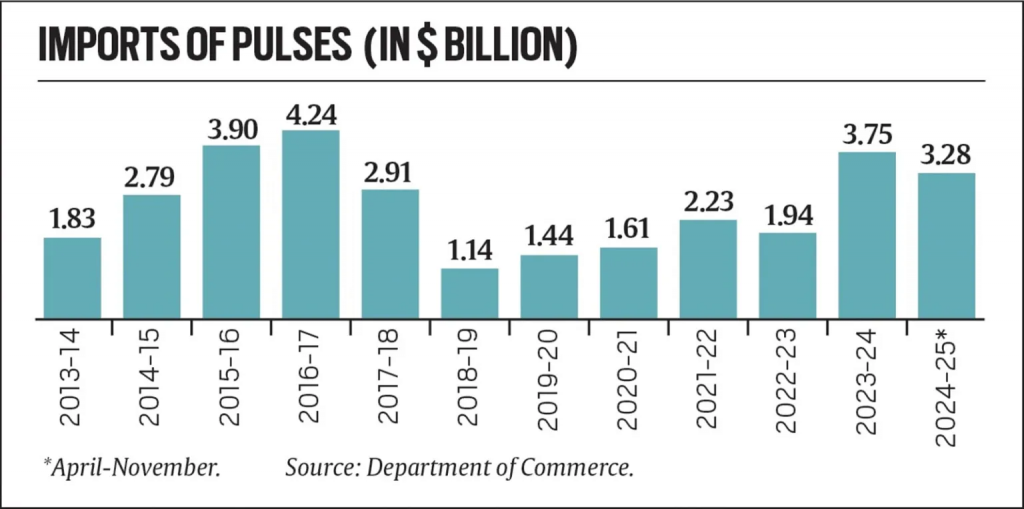Syllabus: GS3/Economy
Context
- The Finance Minister has announced the launch of a six-year ‘Mission for Aatmanirbharta (self-reliance) in Pulses’.
About
- Budget Allocation: Rs 1,000 crore.
- Aim: To boost the output and help achieve self-sufficiency in pulses, with special focus on tur/arhar (pigeonpea), urad (black gram) and masoor (red lentil).
- It will provide minimum support price (MSP)-based procurement and post-harvest warehousing solutions.
- India’s Target: India has set a target to end India’s dependence on imports to meet the country’s pulses demand by 2029.
- Recently the Union Home Minister declared a goal that India will stop importing pulses by 2028-29.
Import of Pulses
- In 2023-24, imports went up 84% higher year-on-year to 4.65 million tonnes, the most in six years.
- In value terms, the country’s spending on imports rose 93% to $3.75 billion.
- India largely imports from Canada, Australia, Myanmar, Mozambique, Tanzania, Sudan and Malawi.

Production of Pulses in India
- India is the largest producer (25% of global production), consumer (27% of world consumption) and importer (14%) of pulses in the world.
- Pulses account for around 23% of the area under food grains and contribute around 9-10% of the total foodgrains production in the country.
- Rabi pulses contribute more than 60 percent of the total production.

- Gram is the most dominant pulse having a share of around 40% in the total production followed by Tur/Arhar at 15 to 20% and Urad/Black Matpe and Moong at around 8-10% each.
- Madhya Pradesh, Maharashtra and Rajasthan are the top three pulses producing states in the country.
- Domestic pulses production increased from 192.55 lt in 2013-14 to 273.02 lt in 2021-22 and 260.58 lt in 2022-23.
- This was mainly courtesy two crops: chana and moong (green gram).
Challenges
- Low Productivity: Pulses have traditionally been a neglected crop because of the instability of its yields.
- Residual Crop: Pulses in India are considered a residual crop and grown under rain-fed conditions in marginal/less fertile lands, with very little focus on pest and nutrient management.
- With the advent of the Green Revolution, which promoted rice and wheat using external inputs and modern varieties of seeds, pulses were pushed to the marginal lands. This resulted in decline in productivity and land degradation.
- Lack of Technological Advances: There has been no technology breakthrough in any of the pulses crops.
- Less Beneficial: Farmers perceive pulses as having a lower cost benefit ratio vis-à-vis other crops like wheat and rice.
- Penetration and adoption of high yielding varieties (HYV) seeds are also low.
- Post Harvest Losses: There are post-harvest losses during storage, due to excessive moisture and attack by stored grain pests especially the pulse beetle.
Measures Taken By the Government to Increase Production
- National Food Security Mission: The Department of Agriculture & Farmers Welfare is implementing the National Food Security Mission (NFSM)-Pulses with the objectives of increasing production through area expansion and productivity enhancement in all the districts.
- Research and Development: The Indian Council of Agricultural Research (ICAR) is undertaking basic and strategic research on these crops and applied research in collaboration with State Agricultural Universities for developing location-specific high yielding varieties.
- PM-AASHA: Government implements an umbrella scheme PM-AASHA comprising Price Support Scheme (PSS), Price Deficiency Payment Scheme (PDPS) and Private Procurement Stockist Scheme (PPSS) in order to ensure Minimum Support Price (MSP) to farmers for their produce of notified oilseeds, pulses and copra.
- Integrated scheme of Oilseeds, Pulses, Oil Palm and Maize (ISOPOM) was launched in 14 major pulses growing states.
- Rashtriya Krishi Vikas Yojna was launched under which states can undertake Pulses Development Programmes.
Way Ahead
- Model Pulses Villages: According to the agriculture ministry’s plan to achieve self-sufficiency, model pulses villages will be set up from the current kharif or summer-sown season.
- Use of Fallow Land: The ministry is also working with states to bring fallow land for cultivation of lentils.
- Hubs: It is set to create 150 hubs to distribute high-yielding seeds.
- Alongside, the farm department will collaborate with the department of agricultural research to promote climate-resilient varieties.
- The government has to ensure crop diversification and incentivize farmers sufficiently across varieties to stop imports.
Source: IE
Previous article
Union Budget 2025-26 :Key Highlights
Next article
News In Short 3-2-2025